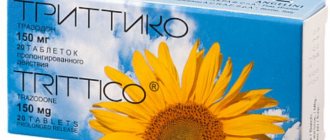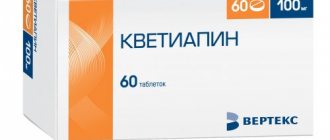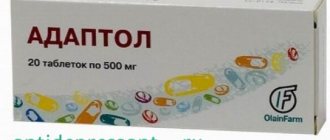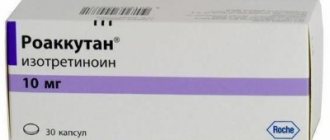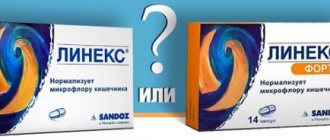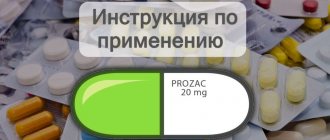Stimuloton is a drug belonging to the group of antidepressants that affect serotonin metabolism. It selectively acts on the structures of the central nervous system, primarily those responsible for the emotional sphere of human activity. This medication is used to treat several mental disorders.
Pharmacodynamics and pharmacokinetics
Pharmacodynamics
Sertraline serotonin reuptake inhibitor . As a result, the concentration of this neurotransmitter increases, eliminating serotonin deficiency, which is the main cause of depressive conditions.
Does not produce a psychostimulating, sedative or m-anticholinergic effect. Has no affinity for serotonergic , muscarinic , GABA receptors and benzodiazepine receptors , does not inhibit MAO. Does not cause drug dependence and weight gain. There is also no cardiotoxic effect of the drug.
The antidepressant effect of the drug is observed by the end of the second week, and the initial effect is in the first week.
Pharmacokinetics
Absorbed from the gastrointestinal tract completely, but slowly. Cmax in the blood is determined after 5-8 hours. Bioavailability increases with simultaneous food intake. 98% bound to blood proteins. Excreted in breast milk. There is no data on the possibility of penetration through the placental barrier. Metabolized in the liver. Excreted in urine and feces. T 1/2 is 22-36 hours.
Pharmacological group
The active substance of Stimuloton, sertraline, is one of the psychotropic drugs of the antidepressant group. Antidepressants are a large and fairly diverse group of medications that can influence the emotional sphere of the psyche, primarily improve mood.
Stimuloton is a selective serotonin reuptake inhibitor (SSRI). In the SSRI subgroup, there are many different drugs that share pharmacological properties.
Stimuloton differs from them in its high selectivity for serotonin and the absence of a significant effect on other brain monoamines.
This fact determines the fewer number of contraindications and the difference in side effects between Stimuloton and other SSRIs.
Indications for use
- depressive states;
- recurrent (repeating) depression ;
- prevention of episodes of depression;
- panic disorders;
- social phobia;
- state of anxiety and depression at the same time;
- obsessive-compulsive disorder;
- stress disorder after trauma.
Contraindications
- recurrent attacks of epilepsy ;
- taking MAO inhibitors ;
- age up to 18 years, except for patients with obsessive-compulsive disorder;
- hypersensitivity to the drug;
- pregnancy and breastfeeding.
Some caution should be exercised when prescribing Stimuloton for manic states , mental retardation, liver and kidney failure .
Side effects of Stimuloton
All side effects are rare:
- drowsiness, dizziness , insomnia , headache, tremor , hallucinations , irritability , restlessness syndrome, agitation;
- dry mouth, stomach cramps, loss of appetite, flatulence , abdominal pain, nausea;
- heartbeat;
- weight loss;
- nosebleeds;
- blurred vision;
- dysmenorrhea , decreased potency, delayed ejaculation;
- skin hyperemia , rash, itching;
- increased sweating;
- increased AST and ALT;
- withdrawal syndrome.
Opinion of consumers and doctors
The majority of consumers give positive reviews about the drug “Stimuloton”. Patients write that the drug helped increase appetite (as a rule, during depression, body weight decreases). There are no feelings of irritability and twitchiness “like from Zoloft”, there is no feeling of detachment from everything in the world, like from antipsychotics. However, a fairly large group of people talk about insomnia accompanying the use of Stimuloton. Some patients were concerned that sertraline might affect weight gain. It turned out that Stimuloton does not give such an effect. There are reviews from individual patients that sexual activity has decreased.
Many patients take the medication for years without any side effects. However, a fairly large percentage of people report the presence of withdrawal syndrome when trying to switch to another antidepressant from Stimuloton.
Reviews from medical professionals mostly characterize the medication as an excellent, highly effective antidepressant. Of course, there are side effects, like any drug, but the use of Stimuloton allows you to achieve a stable state of remission. It can be taken for years as maintenance therapy.
In conclusion, we can say that the modern pharmaceutical industry is ready to offer consumers a fairly large list of antidepressant drugs, which people certainly need in certain difficult moments of life. But these drugs can have a serious impact on the human psyche, and their uncontrolled use can cause catastrophic consequences. Prescribing such drugs is the prerogative of the attending physician. Prescribing antidepressants to yourself without a prescription from an appropriate medical specialist is fraught with serious health problems, and sometimes very disastrous consequences.
Instructions for use of Stimuloton (Method and dosage)
The tablets are taken orally, 1 time per day. The time of admission does not matter (morning or evening).
Treatment of depression and obsessive-compulsive disorder: 50 mg for adults.
For panic disorders, treatment begins with 25 mg, after 7 days the dose is increased to 50 mg. In these conditions, if necessary, the dose is increased by 25–50 mg once a week to the MS dose of 200 mg. The effect of treatment occurs within a week; for a full and lasting antidepressant effect, it takes from 2 weeks to 1 month. The minimum effective dose is prescribed as maintenance therapy.
Children from 13 to 18 years old with obsessive-compulsive disorder - 50 mg. For children 6 to 12 years of age with this condition, 25 mg is recommended, increasing to 50 mg every other week. In the future, it is allowed to increase the dose by 50 mg every week up to an MS dose of 200 mg. Since children have less body weight, the possibility of overdose must be taken into account. For maintenance therapy, the minimum effective doses are selected.
Instructions for use of Stimuloton contain information on the dosage of the drug in certain groups: elderly patients and patients with impaired renal function - the dose is not adjusted, severe liver dysfunction - the dose is reduced.
Instructions:
Clinical and pharmacological group
02.002 (Antidepressant)
Release form, composition and packaging
Film-coated tablets, white or almost white, oval, biconvex, engraved “E271” on one side and scored on the other, odorless.
| 1 tab. | |
| sertraline hydrochloride | 55.95 mg, |
| which corresponds to the content of sertraline | 50 mg |
Excipients: magnesium stearate, hyprolose (hydroxypropylcellulose), sodium carboxymethyl starch (type A), calcium hydrogen phosphate dihydrate, microcrystalline cellulose.
Shell composition: macrogol 6000, titanium dioxide, hypromellose.
10 pieces. - blisters (1) - cardboard packs. 10 pcs. - blisters (3) - cardboard packs.
Film-coated tablets, white or almost white, oval, biconvex, engraved “E272” on one side and scored on the other, odorless.
| 1 tab. | |
| sertraline hydrochloride | 111.9 mg, |
| which corresponds to the content of sertraline | 100 mg |
Excipients: magnesium stearate, hyprolose (hydroxypropylcellulose), sodium carboxymethyl starch (type A), calcium hydrogen phosphate dihydrate, microcrystalline cellulose.
Shell composition: macrogol 6000, titanium dioxide, hypromellose.
14 pcs. - blisters (1) - cardboard packs. 14 pcs. - blisters (2) - cardboard packs.
pharmachologic effect
Antidepressant. Selective serotonin reuptake inhibitor. It has a weak effect on the reuptake of norepinephrine and dopamine. In therapeutic doses, sertraline also blocks the uptake of serotonin by human blood platelets.
Does not have a stimulating, sedative or anticholinergic effect. Sertraline has no affinity for m-cholinergic, serotonin, dopamine, histamine, adrenergic, GABA and benzodiazepine receptors.
When using Stimuloton, there is no increase in body weight. The drug does not cause mental or physical drug dependence.
The antidepressant effect is observed by the end of the second week of regular use of the drug, while the maximum effect is achieved only after 6 weeks.
Pharmacokinetics
Suction
After oral administration, it is absorbed from the gastrointestinal tract slowly, but almost completely. Cmax is reached after 4.5-8.4 hours. When taking the drug simultaneously with food, its bioavailability increases by 25%, Cmax is achieved faster.
Distribution
With a single daily dose of the drug, Css is usually achieved within a week. Plasma protein binding is 98%. Vd - more than 20 l/kg. Sertraline is excreted in breast milk. There is no data on its ability to penetrate the placental barrier.
Metabolism
Sertraline undergoes extensive first-pass metabolism through the liver, undergoing N-demethylation. Its main metabolite, N-desmethylsertraline, is less active than sertraline.
Removal
T1/2 is 22-36 hours and does not depend on the age and gender of patients. T1/2 of N-desmethylsertraline is 62-104 hours.
Excreted in the form of metabolites in urine and feces in equal amounts, 0.2% of sertraline is excreted unchanged in the urine.
Pharmacokinetics in special clinical situations
T1/2 and AUC of sertraline increase with impaired liver function. Pharmacokinetic studies with the administration of the drug in a single dose revealed an increase in T1/2 and AUC of sertraline in patients with mild liver cirrhosis.
Regardless of the severity of renal failure, the pharmacokinetics of sertraline does not change with its continuous use. Sertraline is not eliminated by hemodialysis.
Dosage
The drug is prescribed orally, 1 time/day (morning or evening).
For adults with depression and obsessive-compulsive disorders, the drug is prescribed at a dose of 50 mg 1 time / day.
For panic disorders and post-traumatic stress disorders, to reduce the frequency and severity of side effects, it is recommended to start treatment with a dose of 25 mg 1 time / day and after a week increase it to 50 mg 1 time / day.
If the therapeutic response is unsatisfactory and is well tolerated, the daily dose can be increased by 50 mg over several weeks to a maximum daily dose of 200 mg.
The therapeutic effect is usually achieved within 7 days. However, for the full manifestation of the antidepressant effect, regular use of the drug is required for 2-4 weeks. In obsessive-compulsive disorder, the therapeutic effect develops even more slowly. For maintenance therapy, the minimum effective dose should be prescribed.
For obsessive-compulsive disorders in children aged 13 to 18 years, the drug is prescribed at an initial dose of 50 mg 1 time / day. For children aged 6 to 12 years, the drug is prescribed at an initial dose of 25 mg 1 time / day; after a week, the daily dose can be increased to 50 mg. If the therapeutic response is unsatisfactory, the dose can then be increased weekly by 50 mg/day to a maximum daily dose of 200 mg. To avoid overdose, when increasing the dose to more than 50 mg/day, it should be taken into account that the body weight of children is less than that of adults. For long-term maintenance therapy, the drug should be prescribed in the minimum effective dose.
In elderly patients, no dose adjustment is required.
In patients with severe liver dysfunction, the dose of the drug should be reduced or the intervals between doses increased.
In patients with impaired renal function, no special dose selection is required.
Overdose
Even when sertraline was prescribed in high cases, severe symptoms were not detected. However, administration of sertraline in high doses simultaneously with other drugs or ethanol can lead to severe poisoning.
Symptoms: serotonin syndrome with nausea, vomiting, drowsiness, tachycardia, agitation, dizziness, psychomotor agitation, diarrhea, increased sweating, myoclonus and hyperreflexia.
Treatment: There are no specific antidotes. Intensive supportive care and constant monitoring of vital organ functions are required. Inducing vomiting is not recommended. The administration of activated carbon may be more effective than gastric lavage. The airway must be maintained. Sertraline has a large Vd, and therefore increased diuresis, dialysis, hemoperfusion or blood transfusion may be ineffective.
Drug interactions
When using Stimuloton simultaneously with MAO inhibitors, incl. with selegiline and the reversible MAO inhibitor moclobemide, severe complications are observed. Serotonin syndrome may develop. Several cases of death have been reported with the combination of other antidepressants and MAO inhibitors, as well as with the isolated administration of MAO inhibitors, started immediately after discontinuation of other antidepressants. When a selective serotonin reuptake blocker and an MAO inhibitor were combined, hyperthermia, rigidity, myoclonus, autonomic instability (sometimes with rapid changes in respiratory and circulatory function), mental status changes (for example, confusion, irritability, sometimes with extreme agitation, which could lead to delirium or coma). Therefore, the use of Stimuloton in combination with MAO inhibitors or within 14 days after discontinuation of a MAO inhibitor, as well as less than 1 day after discontinuation of a reversible MAO inhibitor, is contraindicated. Similarly, after discontinuation of Stimuloton, at least 14 days must pass before starting the use of an irreversible MAO inhibitor.
In studies in healthy volunteers, with daily intake of Stimuloton at a dose of 200 mg/day, there was no increase in the effect of ethanol, carbamazepine, haloperidol or phenytoin on cognitive functions and psychomotor reactions. However, while taking sertraline, drugs that affect the central nervous system should be used with extreme caution; the use of ethanol during treatment is contraindicated.
Sertraline is highly bound to plasma proteins and the potential for interaction with other plasma protein-bound drugs (eg diazepam, tolbutamide and warfarin) must be considered.
With simultaneous use of Stimuloton with cimetidine, the clearance of sertraline is significantly reduced.
With the simultaneous use of Stimuloton with coumarin derivatives, a significant increase in prothrombin time is observed (in such cases, it is recommended to monitor the prothrombin time at the beginning of treatment with sertraline and after its discontinuation).
During long-term therapy with Stimuloton at a dose of 50 mg/day, the use of drugs metabolized with the participation of the CYP2D6 isoenzyme is accompanied by an increase in their concentrations in the blood plasma.
In vivo drug interaction studies have shown that long-term administration of sertraline at a dose of 200 mg/day does not affect the endogenous beta-hydroxylation of cortisol mediated by CYP3A3/4 isoenzymes or the metabolism of carbamazepine or terfenadine. Long-term administration of sertraline at a dose of 200 mg/day does not affect the concentrations of tolbutamide, phenytoin and warfarin in blood plasma. This means that sertraline does not inhibit CYP2C9 activity to a clinically significant extent. Long-term administration of sertraline at a dose of 200 mg/day does not affect the concentration of diazepam in the blood plasma, and therefore clinically significant inhibition of the activity of the CYP2C19 isoenzyme should also be excluded. In vitro studies have shown that sertraline has no or minimal inhibitory effect on CYP1A2.
With simultaneous use of Stimuloton and lithium preparations, the pharmacokinetics of the latter does not change. However, with this combination, tremor is observed more often. Just as when prescribing other selective serotonin reuptake inhibitors, increased caution is required when combining Stimuloton with drugs that affect serotonergic transmission (including lithium drugs).
The time required for complete elimination of the active substance from the body before transferring a patient from one selective serotonin reuptake inhibitor to another has not been determined. Therefore, such a transition should be made with extreme caution.
Particular caution is required when other serotonergic substances (e.g. tryptophan or fenfluramine) and sertraline are used concomitantly. Such combinations should be avoided whenever possible.
In clinical studies, only a slight inducing effect of sertraline on liver enzymes was found. With simultaneous use of Stimuloton at a dose of 200 mg/day and phenazone, sertraline caused a small (5%) but significant decrease in T1/2 of phenazone. This small decrease in T1/2 of phenazone was due to a clinically insignificant change in liver metabolism.
When used together, sertraline does not change the beta-blocking effect of atenolol.
When combining Stimuloton at a dose of 200 mg/day with glibenclamide and digoxin, no drug interactions were detected.
Use during pregnancy and lactation
There are no controlled results of the safety of using Stimuloton in pregnant women, therefore its use during pregnancy is contraindicated.
Women of reproductive age who are to be prescribed Stimuloton should be advised to use effective contraception.
Sertraline is excreted in breast milk. There is no reliable data on the safety of its use during lactation. If it is necessary to prescribe Stimuloton during lactation, breastfeeding should be stopped.
Side effects
From the central nervous system and peripheral nervous system: rarely - drowsiness, fatigue, dizziness, headache, tremor, insomnia, irritability, akathisia, hypomania, mania.
As with treatment with other antidepressants, reactions may occur that are difficult to differentiate from symptoms of the underlying disease, including. paresthesia, hypoesthesia, depression, hallucinations, agitation, aggressiveness, agitation, anxiety, psychosis.
From the digestive system: dry mouth, decreased appetite or increased appetite (possibly due to the elimination of depression); rarely - anorexia, cramps in the stomach, abdomen, flatulence or pain, unstable stools, diarrhea, dyspepsia, nausea, vomiting.
From the cardiovascular system: rarely - palpitations.
Metabolism: weight loss.
From the hematopoietic system: bleeding (including nosebleeds).
From the senses: rarely - visual disturbances (including blurred vision)
From the reproductive system: rarely - dysmenorrhea, sexual dysfunction (delayed ejaculation, decreased potency and/or libido, anorgasmia).
Dermatological reactions: rarely - skin hyperemia or “flushes” of blood to the face, increased sweating.
From the laboratory parameters: in some cases (0.8%) - an asymptomatic increase in AST and ALT (these changes were observed during the first 9 weeks of taking the drug and stopped immediately after its discontinuation); There are reports of reversible hyponatremia (presumably this phenomenon is associated with the syndrome of insufficient ADH secretion, since it was observed mainly in elderly patients receiving concomitant diuretics or other drugs).
Other: rarely - allergic reactions, yawning; in some cases, stopping the drug causes withdrawal syndrome.
Sometimes (a causal relationship with the drug has not been reliably established) - motor disorders (extrapyramidal symptoms and gait disturbances), convulsions, menstrual irregularities, hyperprolactinemia, galactorrhea, skin rash (rarely - erythema multiforme), itching. In most cases, movement disorders were observed in patients taking concomitant antipsychotic drugs (neuroleptics), as well as in those with a long history of movement disorders.
Storage conditions and periods
The drug should be stored out of the reach of children at a temperature not exceeding 25°C. Shelf life: 5 years.
Indications
- depression of various etiologies, incl. accompanied by feelings of anxiety (treatment and prevention);
— obsessive-compulsive disorders, incl. in children over 6 years old;
- panic disorders (with or without agoraphobia);
- post-traumatic stress disorder.
Contraindications
- simultaneous use of MAO inhibitors and a period of 14 days after their discontinuation;
- unstable epilepsy;
- age under 18 years (due to lack of sufficient clinical experience), with the exception of patients with obsessive-compulsive disorders;
- pregnancy;
- lactation period (breastfeeding);
- hypersensitivity to the components of the drug.
The drug should be prescribed with caution in case of organic diseases of the brain (including mental retardation), manic states, epilepsy, liver and/or kidney failure, weight loss, as well as children over 6 years of age with OCD.
special instructions
There are no data on the possible risks and benefits of simultaneous use of electroconvulsive therapy and Stimuloton.
Like other antidepressants, Stimuloton® in some cases (approximately 0.4%) can cause mania or hypomania.
Suicidal thoughts and attempts are often associated with depression; they are possible at any time before the onset of remission. Therefore, at the beginning of the course of treatment, until the optimal clinical effect develops, patients need careful medical supervision.
In clinical trials of Stimuloton, epileptic seizures were observed in 0.08% of patients with depression (approximately 3/4000) and in 0.2% of patients with obsessive-compulsive disorder (4/1800). A strict connection between epileptic seizures and the use of Stimuloton has not been established. There is no data on the treatment of patients with epilepsy with Stimuloton. The drug should not be prescribed to patients with unstable epilepsy, and patients who do not have seizures should be monitored regularly. If seizures occur, Stimuloton® must be discontinued.
Sertraline is metabolized mainly in the liver, so caution is required when prescribing Stimuloton to patients with liver disease.
Use in pediatrics
The use of Stimuloton is contraindicated for the treatment of children and adolescents under 18 years of age, with the exception of patients with obsessive-compulsive disorder. Increases in the likelihood of suicide and suicidal ideation, as well as hostility (mainly aggression, defiance and anger), have been observed more frequently in clinical trials among children and adolescents receiving antidepressants compared with groups receiving placebo. If the drug is prescribed for clinical indications, the patient should be monitored to identify suicidal symptoms. In addition, there are no long-term safety data in children and adolescents regarding growth, maturation, and cognitive and behavioral development.
Impact on the ability to drive vehicles and operate machinery
The results of clinical studies showed that monotherapy with Stimuloton does not affect indicators of psychomotor function. However, since other drugs used for similar indications may adversely affect psychomotor reactions, the ability to drive vehicles and machines should be determined individually depending on the patient's response to treatment and the use of concomitant therapy.
Use for renal impairment
Use with caution in renal failure. In patients with impaired renal function, a special dose adjustment is not required.
Use for liver dysfunction
Use with caution in case of liver failure. In case of liver dysfunction, the dose of the drug should be reduced or the intervals between doses increased.
Conditions for dispensing from pharmacies
The drug is available with a prescription.
Overdose
Stimuloton, even in large doses, does not cause severe overdose symptoms. But when it is prescribed with psychotropic drugs, cases of poisoning are observed. Overdose is manifested by the appearance of serotonin syndrome :
- movement disorders (muscle twitching, tremors , bruxism , ataxia );
- autonomic disorders (chills, profuse sweating, nausea, abdominal pain, stool upset, tachycardia , blood pressure fluctuations);
- mental disorders ( disorientation , agitation, hypomania , confusion ).
There are no antidotes. Intensive therapy and monitoring of cardiac activity and respiratory function are carried out. Gastric lavage is not very effective; sorbents .
Interaction
Drugs that affect the central nervous system ( Carbamazepine , Haloperidol , Phenytoin ) should be used with caution. You must abstain from drinking alcohol.
Prescribing monoamine oxidase inhibitors with simultaneous administration of sertraline leads to significant complications in the form of the development of serotonin syndrome . After discontinuation of the drug, treatment with MAO inhibitors begins only after 2 weeks.
Since the active substance binds to blood proteins, this pharmacokinetic feature must be taken into account when prescribing Diazepam , Warfarin and other drugs that also bind to proteins.
Cimetidine reduces the clearance of sertraline.
Tremor is observed when used in combination with lithium , and coumarin increase PT (prothrombin time). Concomitant use with other serotonergic drugs ( Tryptophan , Fenfluramine ) should be avoided.
Compound
The main active ingredient of the drug is sertraline. The dosage indicated on the package corresponds to the concentration of sertraline in each tablet. In addition to the active ingredient, each tablet contains a number of auxiliary components.
Excipients include cellulose and its compounds, magnesium, sodium and calcium compounds. The tablet shell is formed by macrogol, hypromellose and titanium compounds. All excipients have a very low concentration and have no effect on the body.
Analogs
Level 4 ATC code matches:
Actaparoxetine
Plizil
Fluxen
Paroxin
Surlift
Asentra
Elycea
Fluoxetine
Lenuksin
Escitalopram
Adepress
Selectra
Citalopram
Cipramil
Zoloft
Paroxetine
Prozac
Paxil
Rexetine
Fevarin
Aleval , Asentra , Zoloft , Serenata , Sirlift , Thorin , Deprefault , Deprefault , Sertraline hydrochloride .
Reviews about Stimuloton
Reviews about Stimuloton on forums indicate the effectiveness of the drug and the absence of addiction to it when prescribed correctly.
According to patients who took the drug, tension and anxiety gradually go away, there is no excitement or worry about any reason:
“Stimuloton helps! He brought me back to life."
“I’ve been taking Stimuloton for 5 years in a small dose, everything is fine,” “...it started helping me on the second day—the panic attacks stopped.”
“I took the pills for about 6 months, my psychological state improved significantly, I didn’t feel any addiction...”, “...I didn’t feel any addiction either.”
Negative reviews, although there are few of them, are associated with the appearance of side effects, among which the most prominent ones are the appearance of insomnia, fatigue, sweating, apathy and loss of appetite.
Pharmacological properties
Stimuloton is a highly selective serotonin uptake inhibitor. The medication does not allow molecules of the mediator serotonin to enter cells from the intercellular spaces. This increases the concentration of serotonin between neurons and its effect on the nervous system.
Serotonin is one of the mediators that influence the emotional sphere of a person. Decreased mood, depression and anxiety are caused primarily by a decrease in the concentration of serotonin in the brain structures. Stimuloton increases the amount of this mediator and leads to normalization of a person’s emotional background. The difference between this drug and other SSRIs is its high selectivity for serotonin. Stimuloton has no effect on norepinephrine, acetylcholine and dopamine. It has virtually no effect on the autonomic nervous system, therefore it has fewer dangerous side effects.
Stimuloton price, where to buy
You can buy it in pharmacies in Moscow and other cities. The price of Stimuloton depends on the dose of the drug and the number of tablets in the package. The cost of the drug 50 mg No. 10 ranges from 348 rubles. up to 419 rubles, and the drug 100 mg No. 28 - from 1285 rubles. up to 1648 rub.
- Online pharmacies in UkraineUkraine
Pharmacy24
- Stimuloton 50 mg No. 30 tablets ZAT FZ EGIS/VAT Pharmaceutical plant EGIS, Ugorshchina/Ugorshchina
234 UAH.order - Stimuloton 100 mg No. 28 tablets ZAT FZ Egis, Ugorshchina
383 UAH. order
Price range
The price of the drug "Stimuloton" depends on the number of tablets in the pack and on the region. For example, 10 tablets with a dosage of 50 mg can be purchased for 400-410 rubles, 30 tablets will cost 930-1000 rubles. A buyer can buy 14 tablets with a dosage of 100 mg of sertraline for 390-400 rubles. Russian pharmacies offer a drug with the same dosage (100 mg), but 28 tablets for 1450-1540 rubles.
In general, it cannot be said that the drug is cheap and accessible to consumers with any financial capabilities. However, given the high effectiveness of the drug and the fact that one tablet is required per day (and sometimes ½ - 25 mg), it would be wrong to say that this antidepressant is prohibitively expensive.
In some cases, perhaps the right decision would be to consider the cost of analogues of the drug "Stimuloton", the price of which may be slightly lower. For example, 28 tablets of the drug Asentra (50 mg) will cost the buyer 770-780 rubles (versus 930-1000 rubles for Stimuloton). And 28 tablets of the antidepressant Zoloft (100 mg) can be purchased for 1160-1180 rubles (“Stimuloton” - 1450-1540).
In any case, the final word should remain with the attending physician.
